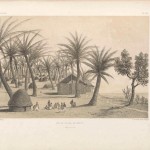The blog post was written by Xavier Courouble for the Warren M. Robbins Library, National Museum of African Art, Smithsonian Institution, on the occasion of the 75th anniversary of Léopold more »
4 search results for "courouble"
The blog post, last of three, was written by Xavier Courouble, research assistant for Sailors and Daughters: Early Photography and the Indian Ocean, an online exhibition part of the Smithsonian’s National Museum of African Art’s Connecting the Gems of the Indian Ocean: From Oman to East Africa.
Charles Guillain’s three-volume work, Documents sur l’histoire, la géographie, et le commerce de l’Afrique orientale and the accompanying atlas folio of lithographs and map engravings, Voyage à la côte orientale d’Afrique give an account of travels undertaken in a pre-colonial context, where European explorers politically and logistically depended on the African inhabitants and sovereigns they encountered in Africa. The interactions experienced by Guillain and his African counterparts allowed for a reaffirmation of exploration as an encounter and a partnership rather than as an unequal confrontation constructing insurmountable otherness.
 The blog post, second of three, was written by Xavier Courouble, research assistant for Sailors and Daughters: Early Photography and the Indian Ocean, an online exhibition part of the Smithsonian’s National Museum of African Art’s Connecting the Gems of the Indian Ocean: From Oman to East Africa. Read the first post in the series here.
The blog post, second of three, was written by Xavier Courouble, research assistant for Sailors and Daughters: Early Photography and the Indian Ocean, an online exhibition part of the Smithsonian’s National Museum of African Art’s Connecting the Gems of the Indian Ocean: From Oman to East Africa. Read the first post in the series here.
From 1836 to 1848, successively in command of the corvette “La Prévoyante,” “La Dordogne,” and finally the frigate “Le Ducouëdic,” Charles Guillain (1808-1875) navigated the Indian Ocean from the Cape of Good Hope to the western coast of the Indian sub-continent. During his several missions he accumulated extensive knowledge on Zanzibar, Madagascar, the Comoros, as well as the Swahili and Somali coast of Africa. Accounts of these expeditions were all published and gave this St. Simonien a solid reputation of ethnologist and geographer. Yet a certain degree of confusion remains of the political and commercial purposes of his ambitious campaigns of exploration, influenced by personal convictions, regional aspirations, and France’s global interest in the region.
The blog post, first of three, was written by Xavier Courouble, research assistant for Sailors and Daughters: Early Photography and the Indian Ocean, an online exhibition part of the Smithsonian’s National Museum of African Art’s Connecting the Gems of the Indian Ocean: From Oman to East Africa.
Recovering from loss of empire following Napoleon’s defeat at Waterloo in 1815, the French sought to re-establish commerce and colonies in the Indian Ocean. The task fell to Charles Guillain, who led a French expedition to the Swahili coast of Eastern Africa in 1846-1848. Our record of his travels is enshrined in a magisterial 3-volume work Documents sur l’histoire, la géographie, et le commerce de l’Afrique orientale and the accompanying atlas folio of engravings and maps, Voyage à la côte orientale d’Afrique.
The Smithsonian Libraries has digitized the complete work of the volumes held by the Warren M. Robbins Library at the National Museum of African Art.
Can't find what you're looking for? Try refining your search:
